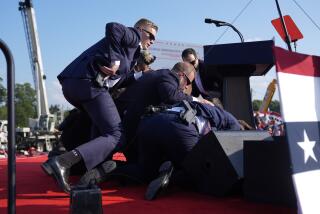Succession Confusion: When The President Is Incapacitated
- Share via
The Constitution has proved to be a marvelously flexibile document, but it is not without its ambiguities and omissions. From time to time efforts are made to deal with these, usually through Supreme Court interpretations, less often when Congress initiates and the states ratify amendments to the basic law. But even the best attempts to clarify sometime fall short in practice. Just what happens--to take a timely example in this election year--when a President is unable to discharge his duties because of a physical or mental disability?
The Constitution says that in such an event the office of President “shall devolve on the vice president.” The original document is silent, however, on how a presidential disability is to be determined, and how a transfer of power should be carried out. This flaw, noted early in the nation’s history, became an issue of immediate concern in 1881, when President James A. Garfield lingered incapacitated for nearly two months after being shot in the back by an assassin. The Cabinet wanted Vice President Chester A. Arthur to take over as acting chief executive since it was clear that Garfield could not carry out his duties. But the Cabinet took no action, in part from concern that the President, should he recover, would be unable to reclaim the office he had surrendered.
THE MECHANISM: A century later President Ronald Reagan was shot in Washington. We know now what the White House tried to hide then: Reagan was a very sick man after the shooting and for 10 days he was effectively unable to function as President. By 1981, however, a mechanism for the temporary transfer of power to the vice president already existed: The 25th Amendment, which took effect in 1967, was intended to fill a constitutional void.
Was thought ever given to invoking its provisions as Reagan lay so critically ill? Daniel Ruge, Reagan’s physician at the time, says “it never entered my mind to use it,” a decision he now says was a “mistake.” But even if Ruge had recommended--which was all that he could do--that Reagan step aside temporarily, there’s a real question whether the President’s personal and political family would have gone along.
THE DEFECT: The 25th Amendment provides two ways for the temporary transfer of executive power: If the President informs Congress in writing that he is unable to discharge his responsibilities, or if “the vice president and a majority of either the principal officers of the executive departments or of such other body as Congress may by law provide” transmit a similar written declaration. The weakness here is that a President who is incapacitated may obviously be unable or unwilling to notify Congress of his need to be replaced. And a vice president and a majority of the Cabinet may be extremely reluctant to take matters into their own hands--no matter how incapacitated the President is--out of fear that either immediately or at some future time they might be accused of usurping power.
In his book, “The President Has Been Shot,” Dr. Herbert L. Abrams looks at the 25th Amendment’s shortcomings and concludes that in its first test, after the attempt on Reagan’s life, it proved “a most miserable failure.” Abrams attributes that to “ignorance, caution, concern and guile” on the part of those closest to the President. Given the political and personal constraints that inevitably come into play when a President is seriously ill, what does Abrams propose? One idea is for an independent panel of experts who would examine the President and publicly report on any disabling condition.
THE NEED: That view is unlikely to be endorsed either by the medical establishment, which assigns high priority to protecting doctor-patient confidentiality, or by those who are keen to keep decision-making on this vital issue at the highest political level. Saying this, though, doesn’t change Abrams’ key point: In its first test the 25th Amendment did not do what its drafters intended. It did not lead to a temporary transfer of power when the President was, as we now know, incapable of functioning as President.
Before a second test comes along, Congress should be thinking about what can be done to give the crucial disability amendment the effectiveness it needs. Presidents are mortal. They can die in office of natural causes, as three have; they can be killed or grievously wounded by assassins, as five have been; they can be incapacitated by illness, as Woodrow Wilson was for the last 18 months of his presidency, or as Dwight D. Eisenhower was three times during his two terms in office. The 25th Amendment needs a fresh look, and clearer guidelines for dealing with presidential disabilty.
More to Read
Sign up for Essential California
The most important California stories and recommendations in your inbox every morning.
You may occasionally receive promotional content from the Los Angeles Times.










